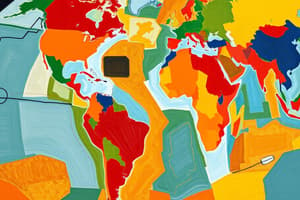Podcast
Questions and Answers
What was a significant result of the introduction of new plants and animals in the Americas?
What was a significant result of the introduction of new plants and animals in the Americas?
- Enhancement of indigenous agricultural practices
- Increase in forest areas due to new agriculture methods
- Stabilization of local ecosystems from biodiversity
- Decrease in soil fertility due to over farming (correct)
Which crop was NOT part of the diffusion to the Americas listed in the document?
Which crop was NOT part of the diffusion to the Americas listed in the document?
- Champa rice
- Wheat
- Rice (correct)
- Citrus fruits
How many enslaved Africans were trafficked into the Americas over the 400 years mentioned?
How many enslaved Africans were trafficked into the Americas over the 400 years mentioned?
- About 10 million (correct)
- About 5 million
- About 20 million
- About 15 million
What role did Christopher Columbus play in the exchange between the Old and New Worlds?
What role did Christopher Columbus play in the exchange between the Old and New Worlds?
What type of migration accounted for 40% of European migrants to the Americas from 1492 to 1820?
What type of migration accounted for 40% of European migrants to the Americas from 1492 to 1820?
Which of the following best describes the health impact of diseases introduced during this time?
Which of the following best describes the health impact of diseases introduced during this time?
What environmental issue increased as a result of cash crop agriculture in the Americas?
What environmental issue increased as a result of cash crop agriculture in the Americas?
Which of the following was NOT a characteristic of the work done by enslaved Africans in the Americas?
Which of the following was NOT a characteristic of the work done by enslaved Africans in the Americas?
What was a significant impact of the Columbian Exchange on indigenous populations in the Americas?
What was a significant impact of the Columbian Exchange on indigenous populations in the Americas?
Which of the following best describes the primary purpose of the Columbian Exchange?
Which of the following best describes the primary purpose of the Columbian Exchange?
Which product was NOT commonly included in the agricultural exchanges of the Columbian Exchange?
Which product was NOT commonly included in the agricultural exchanges of the Columbian Exchange?
What consequence did the Columbian Exchange have on populations in Afro-Eurasia?
What consequence did the Columbian Exchange have on populations in Afro-Eurasia?
What was one of the secondary causes of the Columbian Exchange?
What was one of the secondary causes of the Columbian Exchange?
How did European colonization affect agricultural production in the Americas?
How did European colonization affect agricultural production in the Americas?
Which of the following best characterizes the nature of exchanges during the Columbian Exchange?
Which of the following best characterizes the nature of exchanges during the Columbian Exchange?
What was a major consequence of the forced relocation of African slaves during the Columbian Exchange?
What was a major consequence of the forced relocation of African slaves during the Columbian Exchange?
Which of the following statements about angles is true?
Which of the following statements about angles is true?
In which scenario would a segment bisector be defined?
In which scenario would a segment bisector be defined?
Which is a characteristic of a concave polygon?
Which is a characteristic of a concave polygon?
Which of the following statements correctly describes collinear points?
Which of the following statements correctly describes collinear points?
What distinguishes a ray from a segment?
What distinguishes a ray from a segment?
What is the correct formula to find the distance between two points $(x_1, y_1)$ and $(x_2, y_2)$?
What is the correct formula to find the distance between two points $(x_1, y_1)$ and $(x_2, y_2)$?
Which postulate states that two smaller angles can be added to yield a larger angle?
Which postulate states that two smaller angles can be added to yield a larger angle?
Which formula correctly calculates the area of a triangle given its base $b$ and height $h$?
Which formula correctly calculates the area of a triangle given its base $b$ and height $h$?
What is the contrapositive of the conditional statement 'If it rains, then the ground is wet'?
What is the contrapositive of the conditional statement 'If it rains, then the ground is wet'?
Which of the following best defines a biconditional statement?
Which of the following best defines a biconditional statement?
Which formula calculates the area of a trapezoid with bases $b_1$ and $b_2$ and height $h$?
Which formula calculates the area of a trapezoid with bases $b_1$ and $b_2$ and height $h$?
Which of the following is part of the Laws of Logic?
Which of the following is part of the Laws of Logic?
What does a counterexample prove in logic?
What does a counterexample prove in logic?
Flashcards
Columbian Exchange
Columbian Exchange
The widespread exchange of plants, animals, culture, human populations, technology, and disease between the Americas and the Old World in the 15th and 16th centuries.
Crop diffusion
Crop diffusion
The movement of crops from one region to another, often across trade routes or through migration.
Environmental Impacts (Americas)
Environmental Impacts (Americas)
Introduction of new plants and animals led to changes like deforestation, soil depletion, and water pollution, impacting the natural environment in the Americas.
Transatlantic Slave Trade
Transatlantic Slave Trade
Signup and view all the flashcards
Indentured Servants
Indentured Servants
Signup and view all the flashcards
Impact of Diseases
Impact of Diseases
Signup and view all the flashcards
Cash Crops
Cash Crops
Signup and view all the flashcards
European Migrations
European Migrations
Signup and view all the flashcards
Effect of Exchange on Indigenous Pop.
Effect of Exchange on Indigenous Pop.
Signup and view all the flashcards
Columbian Exchange's Purpose
Columbian Exchange's Purpose
Signup and view all the flashcards
Old World to New World Goods
Old World to New World Goods
Signup and view all the flashcards
European Colonization's role
European Colonization's role
Signup and view all the flashcards
Impact on Afro-Eurasia
Impact on Afro-Eurasia
Signup and view all the flashcards
Cause of the Columbian Exchange
Cause of the Columbian Exchange
Signup and view all the flashcards
Consequences of the Exchange
Consequences of the Exchange
Signup and view all the flashcards
Line
Line
Signup and view all the flashcards
Segment
Segment
Signup and view all the flashcards
Ray
Ray
Signup and view all the flashcards
Plane
Plane
Signup and view all the flashcards
Angle
Angle
Signup and view all the flashcards
Midpoint Formula
Midpoint Formula
Signup and view all the flashcards
Distance Formula
Distance Formula
Signup and view all the flashcards
Perimeter
Perimeter
Signup and view all the flashcards
Area of a Triangle
Area of a Triangle
Signup and view all the flashcards
Area of a Trapezoid
Area of a Trapezoid
Signup and view all the flashcards
Ruler Postulate
Ruler Postulate
Signup and view all the flashcards
Segment Addition Postulate
Segment Addition Postulate
Signup and view all the flashcards
Study Notes
The Columbian Exchange (1450-1750)
- A global exchange of plants, animals, people, and diseases between the Eastern and Western Hemispheres
- Three key developments:
- New connections between the Eastern and Western Hemispheres
- European colonization of the Americas
- Changes in the populations of Afro-Eurasia and the Americas
Main Idea of the Columbian Exchange
- A network of trade and exchange across the Atlantic Ocean
- Exchanged goods from the New World (Americas) and the Old World (Africa, Europe)
- Included plants, animals, cultures, diseases, and people (often through slavery).
- Named after Christopher Columbus, although the exchange predated and outlasted his voyages.
- Europeans took control of the trade and greatly profited from it, while benefiting the Americas' population
- The process expanded from the 15th to the 16th century
Causes of the Exchange
- European conquest of the Americas and the establishment of European-dominated economies and societies
- Increased trade across the Atlantic due to colonization
- Introduction of cash crops like sugar and tobacco (increased in production) in the Americas
Effects of the Exchange
- Diffusion of plants, animals, cultures, and diseases
- Significant changes to the environments of the Americas and other continents (positive and negative)
- Introduced crops like citrus fruits, bananas, and rice from Europe.
- Introduced animals from Europe like horses and pigs.
- Relocation of enslaved Africans to the Americas
- European population expansion in the Americas
- Increased wealth for European powers (Europeans)
- Environmental impacts: deforestation, soil depletion, water pollution, and the introduction of invasive species.
- Impacts on indigenous populations: disease, loss of land, and cultural disruption.
- Long-term consequences across the world (Europe received a large influx on wealth and Africa suffered a reduction in population and human capital.
Food, Production, Decorative, and Medical Impacts
- Columbian Exchange led to the exchange of various goods across the Atlantic.
- Foods: citrus fruits, coffee, wheat, chocolate, tomatoes, potatoes, etc.
- Products: cotton, hemp
- Decorative plants and animals: tomatoes, cinchona trees
- Medical: cinchona tree
Environmental Impacts
- Introduction of new species and diseases resulted in ecological changes in both America and Europe.
- Deforestation, soil depletion, and water pollution emerged as significant consequences.
Human Impacts
- Millions of Indigenous Peoples died due to various diseases.
- 6 million Europeans migrated to the Americas.
- Tens of millions of Africans were forcibly transported (slaves) as part of the exchange.
Studying That Suits You
Use AI to generate personalized quizzes and flashcards to suit your learning preferences.




